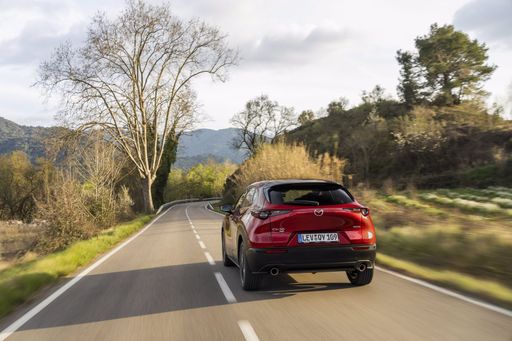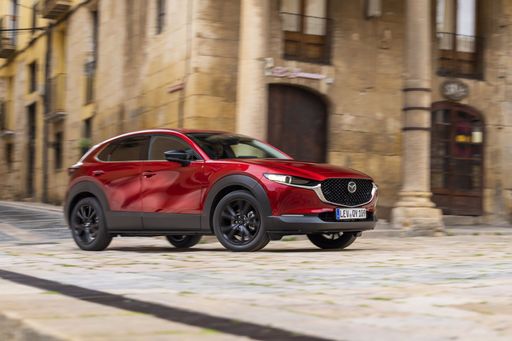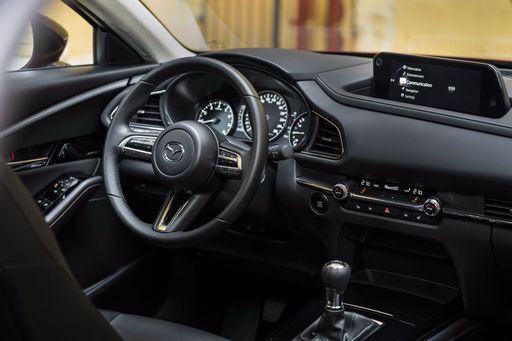Mazda CX-30 vs Ferrari 296 Targa – Performance, range & efficiency compared
Both models have their strengths – but which one suits you more?
Compare performance, efficiency, price and space directly: Mazda CX-30 or Ferrari 296 Targa?
Who comes out on top?
Overall, the Ferrari 296 Targa shows itself to be edges out slightly and secures the title of DriveDuel Champion.
It convinces with the more balanced overall package and proves to be the more versatile choice for everyday use.
 @ Ferrari S.p.A.
@ Ferrari S.p.A.
Ferrari 296 Targa
Mazda CX-30
The Mazda CX-30 blends sleek coupe-like lines with the practicality of a compact crossover, feeling more premium than its price tag suggests. It’s a joy to drive for anyone who likes a taut chassis and an interior that treats daily commutes like a small luxury escape.
details @ Mazda Motor Corporation
@ Mazda Motor Corporation
 @ Mazda Motor Corporation
@ Mazda Motor Corporation
 @ Mazda Motor Corporation
@ Mazda Motor Corporation
 @ Mazda Motor Corporation
@ Mazda Motor Corporation
Ferrari 296 Targa
The Ferrari 296 Roadster captivates with its harmonious blend of cutting-edge technology and classic design, offering a thrilling open-top driving experience. Its powerful hybrid powertrain delivers exhilarating performance while maintaining an emphasis on efficiency and sustainability. The interior combines luxurious materials and advanced connectivity features, ensuring drivers remain engaged and comfortable during every journey.
details @ Ferrari S.p.A.
@ Ferrari S.p.A.
 @ Ferrari S.p.A.
@ Ferrari S.p.A.
 @ Mazda Motor Corporation
@ Mazda Motor Corporation
|
 @ Ferrari S.p.A.
@ Ferrari S.p.A.
|
|
|
|
Costs and Consumption |
|
|---|---|
|
Price
25200 - 36800 £
|
Price
-
|
|
Consumption L/100km
5.7 - 6.6 L
|
Consumption L/100km
-
|
|
Consumption kWh/100km
-
|
Consumption kWh/100km
-
|
|
Electric Range
-
|
Electric Range
-
|
|
Battery Capacity
-
|
Battery Capacity
-
|
|
co2
129 - 148 g/km
|
co2
-
|
|
Fuel tank capacity
48 - 51 L
|
Fuel tank capacity
-
|
Dimensions and Body |
|
|---|---|
|
Body Type
SUV
|
Body Type
-
|
|
Seats
5
|
Seats
-
|
|
Doors
5
|
Doors
-
|
|
Curb weight
1455 - 1587 kg
|
Curb weight
-
|
|
Trunk capacity
422 - 430 L
|
Trunk capacity
-
|
|
Length
4395 mm
|
Length
-
|
|
Width
1795 mm
|
Width
-
|
|
Height
1540 mm
|
Height
-
|
|
Max trunk capacity
1398 - 1406 L
|
Max trunk capacity
-
|
|
Payload
458 - 496 kg
|
Payload
-
|
Engine and Performance |
|
|---|---|
|
Engine Type
Petrol MHEV
|
Engine Type
-
|
|
Transmission
Manuel, Automatic
|
Transmission
-
|
|
Transmission Detail
Manual Gearbox, Automatic Gearbox
|
Transmission Detail
-
|
|
Drive Type
Front-Wheel Drive, All-Wheel Drive
|
Drive Type
-
|
|
Power HP
140 - 186 HP
|
Power HP
-
|
|
Acceleration 0-100km/h
8.3 - 10.3 s
|
Acceleration 0-100km/h
-
|
|
Max Speed
191 - 204 km/h
|
Max Speed
-
|
|
Torque
238 - 240 Nm
|
Torque
-
|
|
Number of Cylinders
4
|
Number of Cylinders
-
|
|
Power kW
103 - 137 kW
|
Power kW
-
|
|
Engine capacity
1998 - 2488 cm3
|
Engine capacity
-
|
General |
|
|---|---|
|
Model Year
2025
|
Model Year
-
|
|
CO2 Efficiency Class
D, E
|
CO2 Efficiency Class
-
|
|
Brand
Mazda
|
Brand
-
|
What drive types are available for the Mazda CX-30?
The Mazda CX-30 is offered with Front-Wheel Drive or All-Wheel Drive.
The prices and data displayed are estimates based on German list prices and may vary by country. This information is not legally binding.
